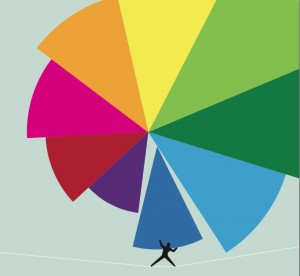Back in summer 2012 I did some research into different ways of thinking about the value created by culture, and about the role of artists in that, as part of an ambitious project started by Exchange, a group of performing arts organisations in Tyneside. They had connected to Mission Models Money (where I’m an Associate) and New Economics Foundation to think about three inter-linked issues: the role of arts and culture within sustainable economic development; how artists and other creative practitioners can contribute to sustainable development and finally how to ensure artists and creative practitioners are able to achieve sustainable livelihoods throughout their life-cycles, especially as emergent independent artists.
At least that’s how we’re describing it in the paper finally published last week: The Art of Living Dangerously. The final document, whose authors were Shelagh Wright, Natalie Querol, Sarah Colston and myself, had a rather protracted gestation, with a number of shifts of focus, and included research, drafting, a ‘theory of change’ workshop with some North East-based practitioners, and sharing of drafts with academic and others. It urges all those working with arts and culture to rethink their contribution to a vision of sustainable development that benefits the whole of society.
It was an interesting and challenging collaboration of style and languages, of cultural policy, (new) economics and artistic thinking. For me the issues came to be less about particular definitions of cultural value within a vision of not simply culture or a economy but society, and more about how the drivers of the cultural ecology, artists (and the creative people who work with them), can develop sustainable livelihoods that mean their contribution to resilient communities and places can be maintained over time.
A couple of quotes to give a flavour:
‘Artists and creative practitioners can invigorate communities both through the work they make but also their presence in local life. Artists and creative practitioners are, Exchange argues, ‘key workers’ and entrepreneurs in the development of healthy and sustainable communities, modelling ways of living that exemplify adaptability, resilience and innovation and contributing to local economies in ways that enhance rather than diminish wellbeing.’
‘We do not express or advocate for the art of surviving in a broken system - an approach that would suggest unsustainable boot-strapping for artists within a system that does not know how to value them - but rather, The Art of Living Dangerously describes the transition to a different model of development. A way to make the lives of emerging artists more visible and viable as well as the policy making logic of the towns and cities of which they are a part.’
Our conclusion admits this paper is an incomplete picture, the start of telling a new story and one we hope will be discussed, contested, critiqued and added to. Reading the nicely designed version I can see signs of it being ‘a work of many hands’, some roads not taken, some juxtaposition where integration proved too difficult, but that may all be no bad thing.
The paper does still feel timely and relevant, as the need to root debates about cultural value in the lives and livelihoods of cultural practitioners becomes ever more important. (This is not to neglect the role of ‘audiences’ and others in cultural value, of course.) Applying ideas of sustainable livelihood development to artists, building on some work in Canada by Judi Piggott, feels to me like a potentially very useful framework for collaborative efforts. (The designers have also made much nicer diagrams than I did!)
The paper sets out some ends by identifying three vital ‘practices’ that can only be achieved by collaboration between artists, institutions and an intelligent funding ecology that creates mutual support:
- Practising Livelihoods: Artists coming together with other creative practitioners and the support of funders to critically reflect on how they create and maintain livelihoods.
- Pooling Risk: Ways for artists and creative practitioners to share the risks of new financial, operational and creative endeavours and models of working.
- Utilising Space: Ways for artists and creative practitioners to access, animate and use unused space in towns and cities.
Do read the paper and let us know what you think, or what you could do – I will post the 10 questions which the paper ends on separately.
(Hmm, may need to work on this ‘cliffhanger’ approach to my blogs…)

Mark - looking forward to reading this. I've come to art late, after a life in manufacturing/consulting, so working in the art/craft space has been challenging: making me think about what 'work' is, the importance of meaning, how the balance changes with time. I'm beginning to think - at least for me - 'art thinking' needs to be balanced, grounded with my other skills/ways of thinking - a bit like they show at Grizedale Arts/ myvillages.org. Not sure how to do it yet though!
ReplyDeletePS thanks for all your thought-provoking writing and being a bridger youself...
Thanks Carys, appreciate the comment. Good luck with your work.
ReplyDelete